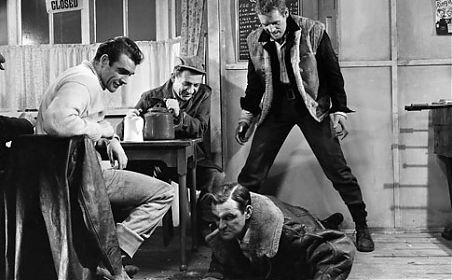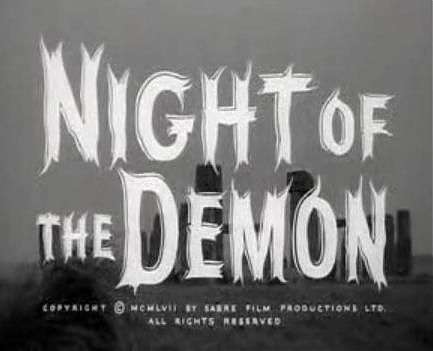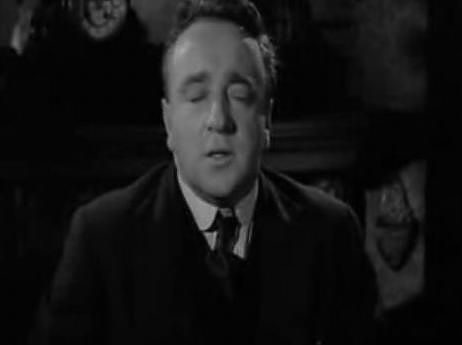Wacky Races
Wednesday June 17, 2009 in 50s cinema |
A bleak and wintry landscape, where truck drivers tear along country lanes at breakneck speed. Britain in 1957; roadside cafes and bed-sitting rooms. An impressive cast featuring Stanley Baker, Patrick McGoohan, Sean Connery, Herbert Lom, David McCallum, Gordon Jackson, William Hartnell and Sid James. You’ve guessed it: Hell Drivers, one of my all time favourite British movies.
Where to start? One of the best things about this film is the cast, and one can easily forget how essential Sid James and Herbert Lom were as supporting actors in the 1950s. Oddly, the least remembered actor from the roll call above is probably the star of the film: Stanley Baker. It’s a shame he’s been forgotten as he always gave strong performances, here impressive as an ex-con who is recruited into a no-nonsense trucking firm.
Cy Endfield’s film has aged surprisingly well. The casting helps, but the writer-director has made a quality film all round, from the excellent script to the well orchestrated truck races. And races they are; once Baker is taken on by the surly boss (Hartnell, giving one of his excellent pre Doctor Who character roles) he realises that he must risk his life every day by driving like a madman to make the required number of deliveries. This is further complicated by his decision to take on the resident maniac (Patrick McGoohan).

For maniacal film roles McGoohan is very good in Hell Drivers, and if he appears a touch over the top the film needs to be forgiven from lurching into melodram from time to time. What the drivers are actually doing in this film is fairly vague; leaving their depot and driving miles across the country as fast as they can, filling up their trucks with grit and then driving back again. Over and over again. “Red” (McGoohan) has decided to be the best at this particular game, pulling such stunts as overtaking on the left, ramming the other trucks that get in his way and tearing across a dangerous quarry that acts as a short cut. There’s no room for Health and Safety in Hell Drivers. The drivers are expected to maintain their own vehicles and seat belts are unheard of (and life threatening as Baker takes his inaugural journey in a truck minus decent brakes). It’s all rather exciting.
So Baker, the softly spoken and quietly tough Welshman, commences battle with the raving Irishman (McGoohan), and eventually almost everyone as he uncovers that Hartnell is running a corrupt outfit. This is the crux of the film, and it works extremely well. Heroes and villains are clearly defined, and the struggle between the good and the bad could easily be transplanted to a different genre, for example a Western. And somewhere, someone has no doubt compared Hell Drivers to specific Westerns, although I personally find the British setting perfect. This film just predates the change in British cinema that was about to take place, and Baker personifies the type of lead that was about to be usurped by the likes of Alan Bates, Tom Courtenay and Albert Finney. Less of an antihero, less ambiguous, just your straightforward British lead. But Hell Drivers manages to convey very well what life in Britain was like more than half a century ago and before anyone had coined the term “kitchen sink”.
Cy Endfield’s most successful film was the better known Zulu that came a few years later. Whilst it also starred Stanley Baker, probably best remembered is the young Michael Caine. Alas, Zulu is now considered a Caine film through and through, although at the time he was relatively unknown and Baker was still the draw.
Typical of Endfield’s films is the lack of good female actors. In Hell Drivers Marjorie Rhodes is fun as a landlady, but Peggy Cummins is quite irritating as the love interest who comes between Baker and Herbert Lom (here playing an Italian from his huge repertoire of stock roles). Cummins just grates, and tends to be responsible for introducing the most melodramatic moments.
But who can beat a film starring the future James Bond, Doctor Who and The Prisoner?
Footnotes:
- This is the earliest film I’ve seen that features the trademark laugh of Sid James.
- A hospital room door has Number One written on it. Patrick McGoohan drives the Number One truck. He calles himself Number One until Baker steals his truck, becoming The new Number One.
- Both McGoohan and Baker turned down the role of James Bond, which of course went to Connery. There is no evidence that the part was ever offered to Sid James.
Comments [2]



